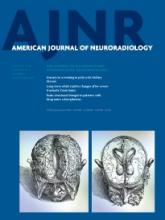Article Figures & Data
Tables
Angiographic Assessment Scale in the Current Study Operator Angiographic Assessment Scalea Core Laboratory Angiographic Assessment Scale Immediately after Embolization Core Laboratory Angiographic Assessment Scale at Follow-Up Grade 1 Complete occlusion Apparently complete occlusion or overlapping coils/neck Complete occlusion Grade 2 Subtotal occlusion or neck remnant Neck remnant Stable neck appearance/neck remnant Grade 3 Incomplete occlusion/aneurysm filling Inflow/incomplete occlusion (body filling) Residual filling ↵a Cases assessed as “failed embolization” by the operators were excluded from the analysis of this study.
- Table 4:
Agreement between operators and the core laboratory reader on different time point assessments
Simple κ Coefficient (95% CI) Interpretation Immediately after embolization on 3-point scale 0.138 (0.067–0.209) Slight agreement Follow-up on 3-point scale 0.189 (0.121–0.258) Slight agreement Favorable versus unfavorable outcomes 0.121 (0.042–0.199) Slight agreement












